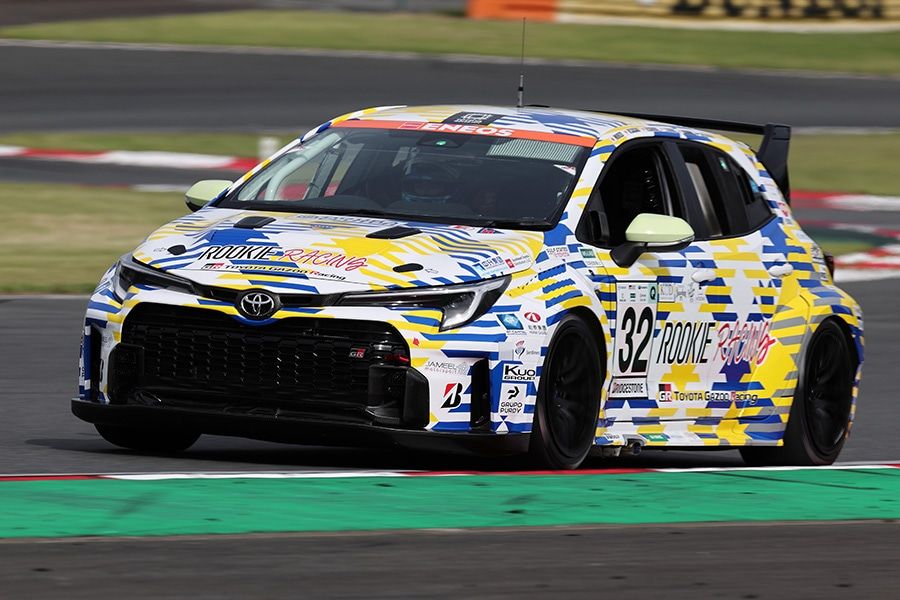Toyota Motor Corporation (Toyota) will enter the ENEOS Super Taikyu Series 2024 Empowered by BRIDGESTONE Round 2 NAPAC Fuji SUPER TEC 24 Hours Race, to be held from May 24 to 26, with the #32 ORC ROOKIE GR Corolla H2 Concept, a hydrogen-powered GR Corolla running on liquid hydrogen.
Toyota will continue to refine cars and people in the challenging world of motorsports and evolve together with its partners to achieve carbon neutrality.

Further evolution of the liquid hydrogen-powered GR Corolla
(1) Improved durability of liquid hydrogen pump
The durability of the pump, which boosts the pressure of liquid hydrogen before sending it to the engine, has been greatly improved in the hopes of completing the 24 Hours Race without the need for replacement. The pump was replaced twice during last year’s 24 Hours Race.
The liquid hydrogen-powered engine generates power by injecting hydrogen, the fuel, directly into the engine for combustion. The liquid hydrogen-powered GR Corolla uses a reciprocating pump that pumps the fuel, converted to a gas inside the car, through the reciprocating motion of a piston when transferring hydrogen from the fuel tank to the engine. Because of the high pressure range this pump generates, the bearings which allow smooth rotation of the shaft and gears on one side of the crank, which transfers torque to the motor by converting reciprocating motion into rotational motion, were unevenly loaded, causing them to wear out and degrade quickly.
This time, a dual-drive crank mechanism has been implemented to improve the pump’s durability. The application of motor torque from both ends of the crank enables the boosting piston to move in a well-balanced manner, thereby significantly increasing pump durability.
(2) Improved cruising range with a custom-shaped tank
The shape of the liquid hydrogen tank mounted to the vehicle has been changed from a cylindrical shape to a custom oval shape, increasing the amount of liquid hydrogen that can be carried and extending the cruising range.
Cylindrical tanks are used for gaseous hydrogen fuel to evenly distribute high pressure, but since liquid hydrogen is lower pressure than gaseous hydrogen, custom-shaped tanks are possible. For this race, the tank has been changed to an oval to make more efficient use of cabin space. As a result, the tank has a capacity 1.5 times higher than that of the cylindrical tank. This doubles the hydrogen volume, and thus cruising range, over the 70 MPa compressed gaseous hydrogen tanks used until 2022.
(3) Automated CO2 capture device process changeover
CO2 capture technology uses the large-volume air intake and heat generated by internal combustion engines to capture CO2 from the atmosphere through a CO2 capture device installed in the engine compartment.
More specifically, a CO2 absorption device is installed at the inlet to the air cleaner, and a CO2 separation device that uses heat from engine oil is installed next to the air cleaner. The separated CO2 is then captured in a small tank filled with an absorbent.
In the final round of the Fuji race in 2023, mechanics manually switched the CO2 absorption and separation processes. However, this time, a mechanism was implemented that automatically switches them by slowly rotating the CO2 absorption filter while driving.
Driver lineup
Masahiko Kondo, director of SUPER GT and Super Formula racing in Japan and the chairman of JRP, which manages Super Formula, and TGR-WRT team principal Jari-Matti Latvala will compete in the Fuji 24 Hours Race. They will join Morizo and other drivers in tackling new challenges in the liquid hydrogen-powered Corolla.
Toyota Times Sports will once again broadcast live in 2024!
Toyota Times Sports will broadcast live from Fuji Speedway for 24 hours from 2:00 PM on Saturday, May 25.
This broadcast will include coverage of the race, live driver appearances, pit stops, and more.
Even if you can’t make it to the venue, cheer on the race together with Toyota Times!We’ll be looking forward to your comments in the chat. https://youtube.com/live/4kTUduc00jc?feature=share
Toyota Times Sports articles archive. https://toyotatimes.jp/sports/
For the full press release, visit https://global.toyota/en/newsroom/corporate/40849748.html.
Copyright ©2024 JCN Newswire. All rights reserved. A division of Japan Corporate News Network.


